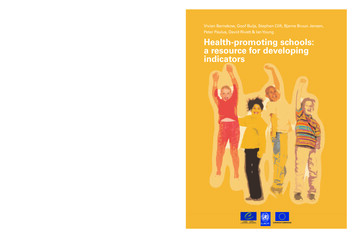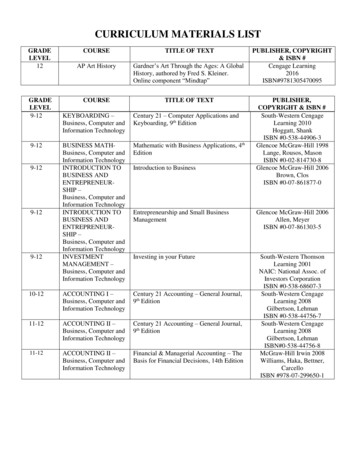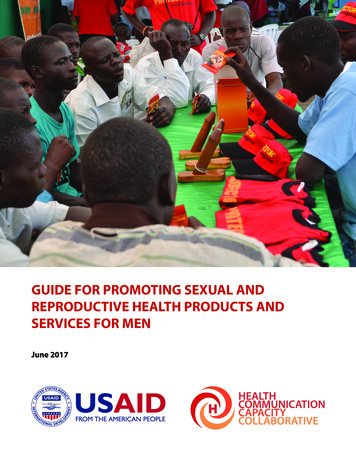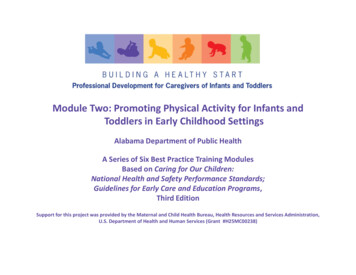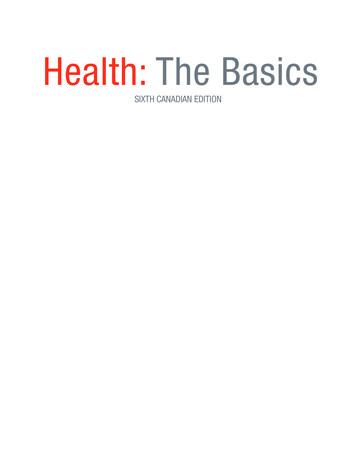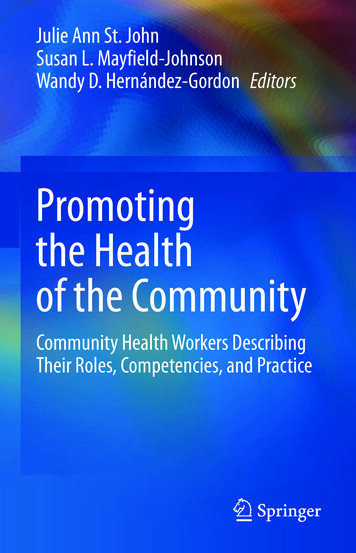
Transcription
Julie Ann St. JohnSusan L. Mayfield-JohnsonWandy D. Hernández-Gordon EditorsPromotingthe Healthof the CommunityCommunity Health Workers DescribingTheir Roles, Competencies, and Practice
Promoting the Health of the Community
Julie Ann St. JohnSusan L. Mayfield-JohnsonWandy D. Hernández-GordonEditorsPromoting the Healthof the CommunityCommunity Health Workers DescribingTheir Roles, Competencies, and Practice
EditorsJulie Ann St. JohnDepartment of Public HealthTexas Tech University HealthSciences CenterAbilene, Texas, USASusan L. Mayfield-JohnsonDepartment of Public HealthUniversity of Southern MississippiHattiesburg, Mississippi, USAWandy D. Hernández-GordonHealthConnect OneChicago, Illinois, USAISBN 978-3-030-56374-5 ISBN -56375-2(eBook) Springer Nature Switzerland AG 2021This work is subject to copyright. All rights are reserved by the Publisher, whether the whole or part ofthe material is concerned, specifically the rights of translation, reprinting, reuse of illustrations, recitation,broadcasting, reproduction on microfilms or in any other physical way, and transmission or informationstorage and retrieval, electronic adaptation, computer software, or by similar or dissimilar methodologynow known or hereafter developed.The use of general descriptive names, registered names, trademarks, service marks, etc. in this publicationdoes not imply, even in the absence of a specific statement, that such names are exempt from the relevantprotective laws and regulations and therefore free for general use.The publisher, the authors, and the editors are safe to assume that the advice and information in this bookare believed to be true and accurate at the date of publication. Neither the publisher nor the authors or theeditors give a warranty, expressed or implied, with respect to the material contained herein or for anyerrors or omissions that may have been made. The publisher remains neutral with regard to jurisdictionalclaims in published maps and institutional affiliations.This Springer imprint is published by the registered company Springer Nature Switzerland AGThe registered company address is: Gewerbestrasse 11, 6330 Cham, Switzerland
ForewordGreetings from the Community Health Worker (CHW) team of Lisa ReneeHolderby-Fox and Durrell Fox. We are pleased to welcome you to Promoting theHealth of the Community–CHWs: Describing Their Roles, Competencies andPractice! Together we have approximately 58 years of experience as CHWs—28and 30 years, respectively. Since the early 1990s, we have served our communitiesboth in paid and volunteer CHW roles in community and clinical settings to promote health. In addition, we have served as CHWs for the CHW workforce—promoting a healthy workforce locally and nationally. We met two decades ago whileorganizing CHWs in Massachusetts to develop a statewide CHW network, whichlater became an association. This led us on the path to promote policy change tosustain and support the workforce, including successfully drafting legislation.We are honored to serve as founding leadership of local, regional, and nationalCHW associations, coalitions, and networks. We have provided guidance to severalnational CHW projects and initiatives—often as a team. These initiatives haveinformed and progressed the local and national CHW movements. Our resumesinclude: providing leadership to the Center For Sustainable Health Outreach(CSHO) and the Unity Conference; the Community Health Worker NationalEducational Collaborative (CHW-NEC); the Health Resources and ServicesAdministration (HRSA) 2007 Community Health Worker National WorkforceStudy; the Community Health Worker Core Consensus (C3) Project; the AmericanPublic Health Association (APHA) CHW Section; and the short-lived AmericanAssociation of CHWs (AACHW). Most recently, we are founding board membersof the National Association of CHWs (NACHW). Additionally, Lisa Renee servedtwo terms as an appointed member to the National Healthcare WorkforceCommission created by the Patient Protection and Affordable Care Act (ACA).Over the years, we have proudly served our communities and contributed toachieving a vision where individuals, families, communities, and the CHW workforce are supported to thrive and to attain their optimal health and growth potential.We acknowledge that inequities and disparities continue to exist and have a profound impact on our communities and the CHW workforce. Hence, the strugglecontinues, and we shall overcome. We celebrate our advances and our continuedv
viForewordwork to address these inequities through utilizing currently available tools and byembracing the development of new resources, including the development of thisbook as a useful tool to apply in education and in practice. We believe the continuedstruggles for health equity have led to valuable lessons learned from each other, ourfamily, communities, peers, and colleagues. We celebrate the dedication, role, andstories of CHWs. However, others have been telling the CHW story for too long.Over the past two decades, we have been encouraging our CHW peers to own andtell their stories and truths. Perhaps that is why the editors of this book, which tellsthe stories of CHW teams across the country, have asked us to contribute by writingthis foreword.We have known and worked with the editors of this book for many years.Although the number of years and projects we have worked together on varies, ourrelationships with the editors are all based on our shared desire to promote, sustain,and elevate the CHW workforce and profession. We have worked closely with ourCHW peer and editor, Wandy D. Hernandez-Gordon, on numerous national CHWprojects, policy efforts, and initiatives, including most recently serving as foundingboard members for NACHW. We have all served as past chairs of the APHA CHWSection. During our terms as chairs of the APHA CHW section, we assisted to leadefforts to develop a national CHW standard occupational code and APHA policiesthat support CHW self-determination and majority involvement on CHW workforcedevelopment task force and initiative teams. Susan Mayfield Johnson is a publichealth practitioner, researcher, and long-time CHW ally whom we have workedwith and collaborated on many CHW professional and leadership developmentopportunities for two decades, including CSHO, the Unity Conference, APHACHW section and other CHW meetings, conferences, and additional training opportunities. We have had the pleasure of working with Julie St. John and the many others as members of the National Community Health Worker Core Consensus (C3)Project team and the APHA CHW Section the past several years. Durrell has alsoworked with Julie on a statewide project in Massachusetts that utilized a curriculumthat Julie developed to train CHWs in the areas of senior home visits to assess safetyand prevent senior falls. In addition to calling these amazing women colleagues,they are also friends. We have met members of their families and have welcomednew members to all their families over the years. We consider them part of our family and valued members of our growing CHW family.A rallying cry for CHW self-determination “Nothing about us, without us!” hasincreasingly been embraced by CHWs and allies nationally over the past few years.This book is an excellent example of an equitable partnership supporting CHWauthors as members of 36 chapter teams made up of approximately 100 authorsfrom across the country, providing a platform for CHWs to articulate and illustratesome of the day-to-day actions and activities that are essential to fulfilling CHWcore roles. Teams of CHWs and allies across the country, consisting of voices fromAlaska, Hawaii, east and west coasts, northern and southern states, and the middleof our country, have contributed their experience and wisdom to bring this book tolife. Although CHWs are a diverse workforce who works in diverse communities,CHW core roles are foundational and common across the country.
ForewordviiChapter 2 weaves the story of the C3 Project—a national project focused onengaging CHWs and stakeholders throughout the research process to build consensus around CHW scope of practice (roles) and CHW competencies, which includeCHW core skills and qualities. The C3 story shares information about the project’smethods and findings and also illuminates valuable information about how the journey of the project findings and recommendations were guided and navigated byCHW leadership on the project team and, even more powerful, were shaped byhundreds of CHWs through a rigorous CHW network/association review process.This book includes several more illustrations of the critical importance of CHWs’role in the journey to advance the workforce. This journey truly models equity andCHW self-determination and leads to a destination that can have a positive impacton our communities, workforce, clinical and nonclinical providers, human services,and health and public health professionals. Part II of the book animates the C3national list of CHW core roles by providing examples from the field representingthe practical application of all ten national CHW core roles in action. To illustratethe core role of providing coaching and social support, there is a great story about“CHWs Extending Solutions to Violence.” Overall, there are CHW models illustrating core roles from approximately 19 states and Tribal nations—which describe thenational CHW scope of practice. There is some useful and practical information forreaders interested in CHWs role in behavioral health, trauma informed care, oralhealth, cultural mediation, and systems navigation.This book provides evidence that our CHW workforce makes a difference inpeople’s lives, communities, and health outcomes. CHWs have been documenteddoing this work in the U.S. for decades and much longer internationally.Unfortunately, among policy makers and healthcare providers, there is still uncertainty of who we are as a workforce and the value we bring. We can think of nobetter resource to share the complete picture of the roles CHWs play, our contributions, impact on the communities we serve, and provide concrete examples, than thevoices of CHWs. This is where the importance of this book lies. More than 20 teamsof CHWs tell their stories. There is beauty in CHWs telling their own stories toprovide examples of our nationally agreed upon core roles. The three editors, one ofwhom is a CHW, have over 60 years combined experience working with the CHWprofession, and all were actively engaged with the C3 project. They are the rightteam to lead this project.Over the course of our long careers, we have seen our workforce grow bothnumerically and professionally. We have seen opportunities for training and education expand and interdisciplinary collaboration and policies developed to supportand sustain the workforce. Even with all the advances within the CHW workforce,there are still basic questions we are often asked like, “What do CHWs do?” and“How do we do it?” Until now, there has not been a comprehensive work to answerthat question. Promoting the Health of the Community: Community Health WorkersDescribing Their Roles, Competencies, and Practice provides some long awaitedanswers.CHWs occupy a special place in community health and wellness as well as in thelives we touch. We have shared our stories with each other, and this book providesa space to share our story with others in a meaningful way. Using the C3 framework
viiiForewordof CHW core roles to share our stories is a unique method to give life to the roles ofCHWs through practical, concrete examples. The editors understand the value ofCHWs telling our stories and have honored, “Nothing about us without us.” You areholding the next chapter in the collective CHW story. A collection of CHW storiesin our own words, supporting the roles and skills of CHWs, is long overdue.Roster Health Stone Mountain, GA, USAJSI Research and Training Institute, Inc. Stone Mountain, GA, USAMarch 2020Lisa Renee Holderby-FoxDurrell Fox
PrefaceWe are honored and elated to share this first edition of this Community HealthWorker (CHW) book. CHWs are increasingly important members of the healthcareand public health professions. Yet, in spite of the exponential growth of CHWsinterventions, CHW training programs, and CHW certification and credentialing bystate agencies, a gap persists in the literature regarding current CHW roles andskills, scope of practice, CHW job settings, and national standards. Hence, the purpose of the book is to provide information about CHWs, the roles CHWs play aschange agents in their communities, describe the integration of CHWs into healthcare teams, and support and recognize the CHW workforce. Specifically, the bookhighlights core roles and skills of CHWs that came from The Community HealthWorker (CHW) Core Consensus (C3) Project. CHW teams across the United Statesshare their stories about core roles they do in their respective communities, with anintroduction to various roles and two examples from CHW teams who explain howthey carry out the respective role, challenges, successes, and lessons learned.The intended audience includes those interested in CHW scope of practice and/or certification/credentialing, CHWs, anyone interested in becoming a CHW, policymakers, CHW payer systems, CHW supervisors, CHW employers, CHW instructors/trainers, CHW advocates/supporters, and communities served by CHWs. Theprimary audience will find this book useful for numerous reasons. First, the bookhighlights nationally recognized standards for CHW roles, skills, and qualities,which were updated in 2016 from the National Community Health Advisor Study in1998; the audience will receive information about these updated standards. Thisbook also tells the story of how CHW teams are practically implementing theseroles within a variety of settings and serving as change agents in their respectivecommunities. Second, this book is written by CHW teams doing the work; eachchapter includes a CHW author. Third, entities considering the CHW model andix
xPrefaceguidance on CHW scope of practice can utilize this book as a guideline developedby other successful CHW programs as defined by the chapter authors.Abilene, TX, USA Hattiesburg, MS, USA Chicago, IL, USA Julie Ann St. JohnSusan L. Mayfield-JohnsonWandy D. Hernández-Gordon
AcknowledgmentsWe could not have completed this book without the thousands of Community HealthWorkers, Community Health Representatives, Promotores, and others in this fieldwho tirelessly serve our communities every single day to make a difference in thelives of its representatives, around our nation and globally. You provided the storiesand the inspiration for this book. Thank you for sharing your thoughts, ideas, challenges, and success stories with us.You contribute to making our community’s health more equitable. You make adifference in the communities you serve; you have made a difference in our lives.We also want to thank Springer staff for their guidance and support in the development of this book, especially Janet Kim. We also want to acknowledge and thankMiranda Rice and Brady St. John for their administrative support in compilingthis book.Lastly, we thank our family, friends, and colleagues who encouraged and supported us throughout this project.xi
ContentsPart I The Story Behind the Book1 Introduction: Why Community Health Workers (CHWs)? 3Julie Ann St. John, Susan L. Mayfield-Johnson,and Wandy D. Hernández-Gordon1.1 Why Community Health Workers? 31.2 Who Are Community Health Workers (CHWs)? 41.3 What Do Community Health Workers (CHWs) Do? 81.4 Why Engage the CHW Model? 9References 92 The Community Health Worker Core Consensus (C3)Project Story: Confirming the Core Roles and Skillsof Community Health Workers 11E. Lee Rosenthal, Durrell J. Fox, Julie Ann St. John,Caitlin G. Allen, Paige Menking, J. Nell Brownstein, Gail R. Hirsch,Floribella Redondo- Martinez, Lisa Renee Holderby-Fox,Jorge M. Ibarra, Colton Lee Palmer, Alexander Ross Hurley,Maria C. Cole, Sara S. Masoud, Jessica Uriarte Wright,and Carl H. Rush2.1 Introduction to the Community Health WorkerCore Consensus (C3) Project 122.2 Factors Impacting Growth and Developmentof Community Health Workers in the United States 132.2.1 Implications for the C3 Project 132.2.2 Integration of CHW Leadership and OtherStakeholder Input Is a Key Value of the C3Project Research Team 152.3 A Look at Scope of Practice and CompetencyDevelopment in the Health Sector 162.4 C3 Project Methods and Implementation 172.4.1 Phase 1 17xiii
xivContents2.4.2 Dissemination 212.4.3 Phase 2 212.5 C3 Project Recommendations 242.5.1 Phase 1 242.5.2 Roles 242.5.3 Skills 252.5.4 Qualities 252.5.5 C3 Project Phase 1 Recommendations:CHW Roles and Competencies 252.5.6 Phase 2 262.6 Holding the Door Open: C3 Project Disseminationand Ongoing Work 322.6.1 What Does This All Mean for CHWsand the Wider Development of the Fieldand Its Contributions to Improved Health? 32References 343 Roles, Skills, and Qualities of Community Health Workers 37Noelle Wiggins and Keara RodelaReferences 404 Describing Results from the “Promoting the Healthof the Community” National Needs Assessment 43Danielle Fastring, Susan L. Mayfield-Johnson, Julie Ann St. John,and Wandy D. Hernández-Gordon4.1 Demographics of All Survey Respondents 444.2 Community Health Workers 454.2.1 Employment Characteristics 454.2.2 Barriers to Effectiveness 464.2.3 Supervision 474.2.4 Experience with Evaluation and Research 474.3 CHW Instructors or Trainers 484.3.1 Employment Characteristics 484.3.2 Training and Instruction for CHWs 484.4 CHW Supervisors 494.5 CHW Stakeholders, Supporters, or Allies 504.6 Employers of CHWs 514.7 Conclusion 52Part II CHWs Describe Their Roles Through Their Stories5 Cultural Mediation Among Individuals, Communities,and Health and Social Service Systems 55Caitlin G. Allen, Diane Garzon Arbelaez, Cinthia Arechiga,Anastasia Belliard, Juan Carlos Belliard, Megan Daly,Yaminette Diaz-Linhart, Emily Feinberg, Ivys Fernandez-Pastrana,Gail R. Hirsch, Alejandra Morales, Niem Nay- Kret, Silvia Ortega,Floribella Redondo-Martinez, and Carl H. Rush
Contentsxv5.1 Introduction 55Caitlin G. Allen, Carl H. Rush, Gail Hirsch,and Floribella Redondo-Martinez5.2 A Dose of Cultural Humility: Cultural Mediationand CHW/Promotores’ Contribution to Health Care 57Juan Carlos Belliard, Anastasia Belliard, Cinthia Arechiga,Alejandra Morales, Silvia Ortega, and Megan Daly5.2.1 Cultural Humility: Promotes Critical Reflectionand Lifelong Learning 645.2.2 Cultural Humility: Addresses Power Imbalanceand Equity 685.2.3 Cultural Humility: Institutional Accountability 695.2.4 Cultural Humility and Healthcare Professionals 705.2.5 Next Steps/Conclusion 735.3 Community Health Workers and BehavioralHealth Prevention 75Yaminette Diaz-Linhart, Ivys Fernandez-Pastrana,Diane Garzon Arbelaez, Niem Nay-Kret, and Emily Feinberg5.3.1 Introduction 755.3.2 Roles of Community Health Workers in BehavioralHealth Prevention 775.3.3 CHW Behavioral Health Prevention Interventions 785.3.4 Impact on Using Community Health Workersfor Behavioral Health Prevention 795.3.5 Challenges 825.3.6 Lessons Learned 836 Providing Culturally Appropriate Health Educationand Information 87Caitlin G. Allen, Arika Makena Bridgeman-Bunyoli,Teresa Campos Dominguez, Francis Kham, Ella Miller,Katie Miller, Sue Miller, Linda J. Nisley, Alix Sanchez,Lizdaly Cancel Tirado, Doretta Thomas, Melissa K. Thomas,Kelly Volkmann, and Noelle Wiggins6.1 Introduction 87Noelle Wiggins and Caitlin G. Allen6.1.1 History of CHWs as Health Educators 886.1.2 Definition of the Role 896.2 Providing Culturally Appropriate Health Educationin Amish Country 91Melissa K. Thomas, Ella Miller, Linda J. Nisley, Doretta Thomas,Katie Miller, and Sue Miller6.2.1 Introduction 916.2.2 Background 926.2.3 Program Description 946.2.4 Roles of the CHW 96
xviContents6.2.5 Part of the Community 986.2.6 Rewards 996.2.7 Challenges 1006.2.8 Importance of Education/Certification 1016.2.9 As a Survivor 1016.2.10 Lessons Learned 1026.2.11 Advice in Working with Amish and MennoniteCommunities 1026.2.12 Conclusion 1046.3 Community Health Workers: Trauma-Informed,Culturally Centered, Decolonizing Popular Educators 107Arika Makena Bridgeman-Bunyoli, Teresa Campos Dominguez,Lizdaly Cancel Tirado, Francis Kham, Alix Sanchez,Kelly Volkmann, and Noelle Wiggins6.3.1 Introduction 1076.3.2 The Spectrum of Health Education Approaches 1076.3.3 Introduction to Popular (People’s) Education 1086.3.4 History and Definition of Popular (People’s) Education 1096.3.5 Methodology in Popular (People’s) Education 1096.3.6 Popular (People’s) Education: Trauma-Informed,Culturally Centered, and Decolonizing 1106.3.7 Capacitating CHWs to Use Popular (People’s)Education 1116.3.8 Case Studies of CHWs Sharing Health Education 1126.3.9 Conclusion 1217 Care Coordination, Case Management, and System Navigation Caitlin G. Allen, J. Nell Brownstein, S. Kim Bush,Cecil H. Doggette, Durrell J. Fox, Paige Menking, Judith Palfrey,Kate Philley Starnes, Aubry D. Threlkeld, and DelAnne Zeller7.1 Introduction Caitlin G. Allen, Durrell J. Fox, J. Nell Brownstein,and Paige Menking7.2 Establishing a Patient Care Navigation System S. Kim Bush, Kate Philley Starnes, and DelAnne Zeller7.2.1 Introduction 7.2.2 Description of Geographic Location/Population 7.2.3 Implementation from the Front Lines 7.2.4 Pilot Results 7.2.5 Successes 7.2.6 Challenges 7.2.7 Lessons Learned 7.2.8 CHW Highlight 7.2.9 Personal Stories 7.2.10 Conclusion 125125127127127128130131132132133134138
Contents7.3 Special Connections: CHWs Engaged with CSHCNand Their Families Cecil H. Doggette, Aubry D. Threlkeld, and Judith Palfrey7.3.1 Special Children, Special Families, and SpecialCommunities 7.3.2 CHWs as Trailblazers 7.3.3 Veteran CHW Voices Shape Learning 7.3.4 Aims of the Curriculum 7.3.5 The Value of Continuous Learning 7.3.6 Advice for the Future xvii1401401411431431471498 Providing Coaching and Social Support 151Caitlin G. Allen, Alexandra Anderson, Melinda Banks,Gabriela Bustos, Maria C. Cole, Carolyn Dixon, Princess Fortin,Almitra Gasper, Kim Jay, Stephanie Jordan, Rhonda M. Lay,Javier Lopez, Helen Margellos-Anast, Fatima Padron, Michael Perry,Floribella Redondo-Martinez, Carl H. Rush, Jessica Sunshine,and Madeline Woodberry8.1 Introduction 152Caitlin G. Allen, Maria C. Cole, Floribella Redondo-Martinez,and Carl H. Rush8.2 Community Health Workers Extend Solutionsto Violence Prevention 153Princess Fortin, Jessica Sunshine, Alexandra Anderson,Michael Perry, Carolyn Dixon, Almitra Gasper, and Javier Lopez8.2.1 Introduction 1538.2.2 Disparities in Community Gun Violence in NYC 1548.2.3 CHW Support and Coaching: Essentialfor Gun Violence Prevention 1588.2.4 Conclusion 1648.3 CHWs: A Bridge to Wellness 167Kim Jay, Fatima Padron, Helen Margellos-Anast,Madeline Woodberry, Melinda
Promoting the Health of the Community: Community Health Workers Describing Their Roles, Competencies, and Practice provides some long awaited answers. CHWs occupy a special place in community health and wellness as well as in the lives we touch. We have shared our stories

